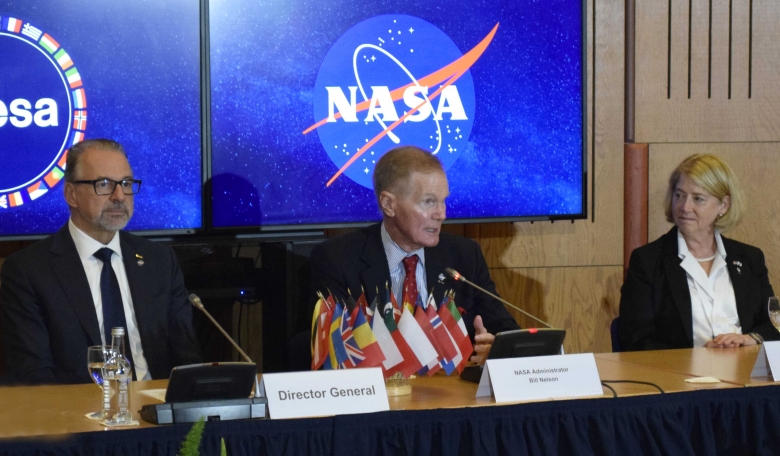The possibility of the first-ever European astronaut to set foot on the Moon, a telecommunication satellite for lunar exploration, and a mission to return precious rock samples from Mars were all on the agenda this week (14 and 15 June) at ESA’s Council meeting in ESA/ESTEC, the Netherlands.
NASA Administrator Bill Nelson and his deputy Pam Melroy joined the meeting in a decisive gesture to support Europe’s influential role in multiple projects.
“From understanding our changing planet to exploring Mars, I hugely value the cooperation we have with NASA” said ESA Director General Josef Aschbacher. “By contributing key European hardware and services to exciting programmes such as Artemis and Mars Sample Return we are building Europe’s autonomy while also being a reliable partner.”
Nelson told a post-meeting press conference that NASA was “counting on cooperation with ESA” to propel exploration of the Moon through the Artemis programme. “The European Service Module is the powerhouse of the Orion spacecraft, providing our astronauts with in-space manoeuvring capabilities, life support and power that will safely transport our astronauts to the Moon and back home to Earth,” he said.
“We look forward to having an ESA astronaut join us on the surface of the Moon and continuing to build on our longstanding, critical partnership,” Nelson added.
A ride to the surface of the Moon for a European could be the benefit of fresh ESA contributions to Artemis. Still to be negotiated European contributions could include delivery of cargo and infrastructure to the Moon by the European Large Logistic Lander (to be named Argonaut), communication and navigation services through the proposed Moonlight programme, as well as science and technology for surface exploration. These projects among others will be on the table for discussion at the ESA Council of Ministers in Paris later this year.
A key step towards this vision was agreed in an innovative agreement signed by the ESA Director General and the NASA Administrator at the ESA Council.
UK company SSTL is already building Lunar Pathfinder, the first commercial lunar telecommunications relay satellite available for users worldwide, which NASA will deliver to lunar orbit through the Commercial Lunar Payload Services initiative. In return, ESA will provide NASA with access to lunar telecommunications.
Later, in a unique ESA-NASA collaboration, tests will be made using satellite navigation signals and laser ranging to demonstrate a satnav positioning fix in lunar orbit for the first time.
These tests will be a valuable step towards Moonlight, the vision of which is to create a network of communications and navigation satellites supporting Lunar exploration, just as today we navigate using Galileo and GPS on Earth.
ESA and NASA also signed a Framework Agreement for a Strategic Partnership in Earth System Science. The two agencies plan to lead a global response to climate change, through the monitoring of the Earth and its environment with combined efforts in Earth science observations, research, and applications, in support of adaptation and mitigation measures.
“When it comes to global challenges such as the climate crisis, we each have our role to play,” said Aschbacher. “It’s only by joining forces that we can achieve more and, with leadership on both sides of the Atlantic, we are more committed to tackle this than ever. ESA and NASA have a historic chance to further make space an integral part of the solution when it comes to climate change mitigation.”
NASA counts on ESA cooperation for lunar exploration











